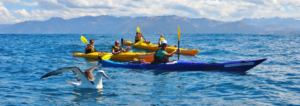Pros And Cons of Hypalon For Inflatable Kayaks and Canoes
There are two main materials used in the construction of most best inflatable kayaks and inflatable canoes on the market today. They are PVC along with Hypalon. When I first entered the field of inflatable kayaking I was much more then just a bit confused in regards to what the differences between the two components were and why I ought to be concerned about them.
Though each materials have their strengths and weaknesses, there exists a significant diffference between them. I really hope that this article will help to supply you with a foundational knowledge of one substance, Hypalon, and will aide a person in your search for a new ship.
Hypalon was Dupont’s branded name, up until 2010, regarding chlorosulfonated polyethylene (CSPE). The product is a special type of artificial rubber. For over the last 20 years or so, this fabric is the most widely used in the making associated with inflatable kayaks.
Pros
Kayaks made out of hypalon are resistant to chemical substances, extreme temperatures, salt water, oxidation, in addition to ultraviolet (UV) light. For that reason the unrivaled durability of hypalon makes it an excellent choice intended for inflatable kayaks.
Hypalon has a lengthier life expectancy than PVC.
Hypalon kayaks are more resistant to scratching when dry.
They show better air retention within cold weather as well as cold h2o than PVC.
Because of their rubber-like properties, they do not crease because easily as PVC.
Negatives
Any kayak made with hypalon fabric will carry additional money00 tag than those made from PVC. The main reason is the high cost of the material itself.
Hypalon kayaks are generally slightly heavier than PVC ones.
They attract dust easily because of their porous exterior layer.
They do not glide since effortlessly over rocks while do PVC kayaks.
All of a hypalon kayak needs to be hand glued. This makes the actual manufacturing more laborious and for that reason adds to them being more costly.
Repairing rips, tears, etc on an inflatable hypalon boat is very time consuming. This is therefore because repairing these types of kayaks requires a two-part glue. The actual glue itself is temperature and pressure sensitive.
The majority of choices require a tradeoff so when you purchase your first inflatable kayak or maybe canoe you will face picking out what fabric to pick. I am hoping that this article has provided a better understanding of one of the main fabric used in the construction of inflatables and canoes.
 Paddle Weekend Your Paddle Weekend
Paddle Weekend Your Paddle Weekend
